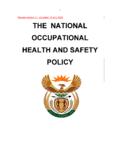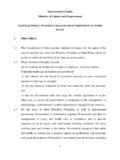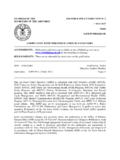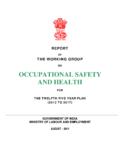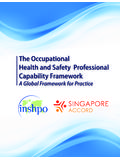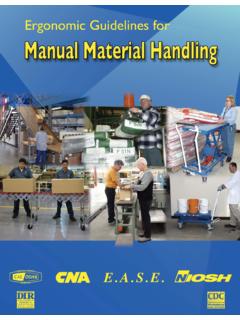Transcription of OCCUPATIONAL SAFETY AND HEALTH
1 OCCUPATIONAL SAFETY AND HEALTH . COUNTRY PROFILE TANZANIA. November 2004. Abstract The United Republic of Tanzania is a country situated in East Africa bordering with Kenya and Uganda (north), Rwanda, Burundi and the Democratic Republic of Congo (west), Zambia, Malawi, and Mozambique (south) and the Indian Ocean (east). The country has a population of about 35 million people out of which 49% are males and 51% females. The total workforce is estimated at 17 Million people; most of these (82%) are employed in agriculture sector. Very few are employed in electricity or gas related activities ( ), mining/quarry ( ) and finance ( ). As a result, major shares of GDP emanate from agriculture (43%), services (40%) and industrial sector ( ). Unfortunately, the magnitude of OCCUPATIONAL accidents and diseases arising from these economic activities is yet to be ascertained due to lack of a coordinated national reporting system for such incidents.
2 However, starting from August 2003, OHS matters have gained a new impetus due to enactment of a new OCCUPATIONAL HEALTH and SAFETY Act; providing for SAFETY and HEALTH of people at work. The Act covers economic activities in constructions, agriculture, commerce, and offices. Also in the making is the OHS national policy; the formulation of which has adopted the tripartite approach involving the government, employers and employees. Apart from the OHS Act of 2003, there are other principal legislations related to OHS;. which are The Atomic Energy Act (2003), The Industrial and Consumer Chemicals Act (1985), The Tropical Pesticides Research Institute Act (1979), and The Pharmaceuticals and Poison Act (1978). Overall, the Ministry of Labor, Youth Development and Sports through its executive agency - OSHA, is responsible for coordinating the policy making and implementation of OHS laws. In case of OCCUPATIONAL accidents/illness, it is the responsibility of the labor department in the ministry to ensure the victim get compensated by the insurer of the employer.
3 Moreover, the victim may also claim for work-injury benefit should he/she be a member of a social security scheme. i Contents List of Figures iv List of Tables v 1 OSH LEGISLATIVE FRAME 1. References to OSH Requirements in the Constitution of the Country .. 1. Legislation Concerning OCCUPATIONAL HEALTH and SAFETY .. 1. OCCUPATIONAL HEALTH and SAFETY Act No. 5 of 2003 .. 1. Law and Regulations Related to OSH Issued Under Other Ministries .. 4. The Tropical Pesticides Research Institute (TPRI) Act.. 4. The Atomic Energy Act, 2003 .. 4. OSH Regulations under the Mining Act .. 5. The Fire and Rescue Services Act .. 5. Pharmaceuticals and Poisons Act .. 5. The Industrial and Consumer Chemicals Act .. 5. 2 POLICY STRUCTURE AND RESPONSIBILITIES 6. National Policy Review Mechanism .. 6. 3 COORDINATION AND COLLABORATION INCLUDING COLLEC- TIVE BARGAINING AGREEMENTS 6. National level .. 6. Enterprise level.
4 6. 4 OSH TECHNICAL STANDARDS, GUIDES AND MANAGEMENT. SYSTEMS 7. Technical Standards .. 7. ii 5 OSH IMPLEMENTATION SYSTEM - MEANS AND TOOLS 7. OSH Supervisory Authorities .. 7. Inspection and Enforcement System .. 7. OSH Research Institutes and OSH Laboratories .. 8. OSH Information Centre .. 9. OCCUPATIONAL HEALTH Services .. 9. Workmen's Compensation Services/Insurance Schemes .. 9. Poison Control Centers .. 9. Education, Training and Awareness Raising Structures .. 10. University and College Courses Related to OSH .. 10. Institutions With Linkages to Various Aspects of OHS .. 10. Tanzania Bureau of Standards (TBS) .. 10. Government Chemist Laboratory .. 11. Tanzania Pesticide Research Institute .. 12. Disaster Management Unit (DMU) .. 12. Private OHS Institutions .. 13. Overall National Level of Human Resource .. 14. 6 Statistics of OCCUPATIONAL Accidents and Diseases 14. 7 Eliminating Child labour 14.
5 International Programme on the Elimination of Child labour (IPEC) in Tanzania .. 15. Government Policy Towards Child Labour .. 15. Tanzania's Time-Bound Programme-TBP .. 16. 8 Polices and Programmes of Employers' and Worker's Organization 17. iii Employers Organization .. 17. Workers' Organization .. 17. OSH Policy Statement .. 17. Structure and Policy Implementation .. 18. Programmes: Training and Information to Members .. 18. OSH Elements in the Collective Bargaining .. 18. Participation in the National Tripartite Dialogue .. 18. 9 Regular and On Going Activities Related to OSH 18. Regular Activities at the National Level to Improve the Level of Preven- tion and Protection .. 18. National Initiative for Awareness Campaign .. 18. Industry Initiatives .. 19. Trade Unions OSH Activities and Initiatives .. 19. International Capacity Building .. 19. Africa Stockpile Programme .. 21. 10 General Data 22.
6 Demographic Data .. 22. Economically Active Population .. 22. Literacy Levels .. 24. Labour Force .. 24. Selected Economic and Financial Indicators .. 27. 11 Other Relevant Information 28. iv List of Figures 1 Organization Chart- OCCUPATIONAL SAFETY and HEALTH Authority .. 8. List of Tables 1 Overall National Level of Human Resource .. 14. 2 Total Population - Tanzania .. 22. 3 Currently Economically Active Population .. 22. 4 Percentage of Economically Active Population in the Informal Economy: Main and Secondary Activities .. 23. 5 Literacy Levels by Sex .. 24. 6 Literacy Rate of the Labour Force during 1990/91 and 2000/01 (Percentage) 24. 7 Employed Person by Industry and Status of Employment( ) 2000/01 25. 8 Distribution of the Currently Employed Population by Sex and Industry 2000/01 .. 26. 9 Selected Economic and Financial Indicators .. 27. 10 GDP - Composition by Sector (2003 estmations).
7 27. v 1 OSH LEGISLATIVE FRAME. References to OSH Requirements in the Constitution of the Country The constitution of the United republic of Tanzania Articles 13 - 29 highlight the basic rights to work. In particular, article 14 of the constitution gives the right to live for everyone. Otherwise there is no direct reference to OSH requirements in the country's constitution. The earliest legislation, in Tanzania regarding OHS (The Factories Ordinance Cap. 297). was promulgated in 1950 and it became operational from January 1952. This legislation laid emphasis on the protection of workers HEALTH and in factories; hence leaving most sectors uncovered. There have been other inter-sectoral legislations complementing the Factories Ordinance. Due to non-compliance of ILO Conventions and limited scope of the Factories Ordinance, together with its obsolescence a new legislation OCCUPATIONAL HEALTH and SAFETY Act 2003 has been enected.
8 This new act has widened the scope of application and recognizes roles played by other public and private institutions. Legislation Concerning OCCUPATIONAL HEALTH and SAFETY OCCUPATIONAL HEALTH and SAFETY Act No. 5 of 2003. This is a new piece of legislation, which came into effect as from 1st August 2003. This Act repealed the Factories Ordinance Cap. 297 of 1950. The objectives of this Act is to provide for the SAFETY , HEALTH and welfare of persons at work in factories and other places of work; to provide for the protection of persons other than persons at work against hazards to HEALTH and SAFETY arising out of or in connection with activities of persons at work. OHS Act applies to all establishments in the private and public sector, local government services and public authorities. National OHS legislation includes provisions applicable to the following branches of eco- nomic activity: 1.
9 Construction Commerce and offices Agriculture - OHS Act, section 65 provides specific provisions for agricultural work- ers, in particular that the employer is to ensure that no worker is exposed to haz- ardous machinery or equipment, harmful animals and insects, infectious agents or allergens, hazardous chemicals or hazardous environments National OSH legislation includes provisions concerning the following OCCUPATIONAL haz- ards: Air pollution Noise Ionizing radiations - OHS Act, section 70 provides that measures shall be taken so that as far as practicable, workers are not exposed to ionizing radiations. Chemicals - OHS Act, Part VII (sections 66- 72) deals with hazardous materials and processes and Part VIII (sections 73- 76) deals with chemicals Apart from the OHS Act there have been some other major laws and regulations on OHS which are still operational; these are;- The Factories (Building Operations and Works of Engineering Construc- tion) Rules of 1985 which makes provisions for SAFETY , HEALTH and welfare of persons engaged in building operations and works of engineering construction un- dertaken by way of trade or business or for the purpose of any industrial or commer- cial undertaking; and to building operations and works of engineering construction undertaken by or on behalf of the Government, a local authority or a public body.
10 This regulation is fairly comprehensive, but one of the implementation shortcomings noted from this study was little awareness of the same among the stakeholders. It was not yet clear why there was very little awareness of this subsidiary legislation. One of the possible reasons could be weak enforcement by the competent authorities. The Woodworking Machinery Rules, 1955 which make provisions for all fac- tory premises or other workplaces in which woodworking machinery such as circular saw, plain band saw, planning machine, vertical spindle moulding machine, chain mortising machine, is used. The Factories (Electricity) Amendment rules, 1985 which extend and ap- ply to the generation, conversion, switching, controlling, regulating, distribution, 2. construction and maintenance of transmission and service lines, power stations and sub-stations, and safe use of electrical energy in any factory and in any premises, place, process, operation or work.










